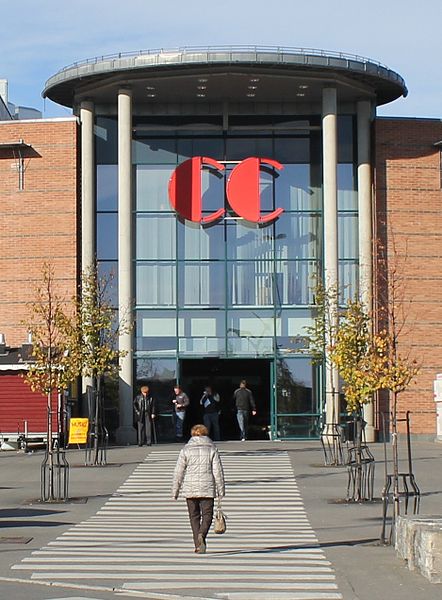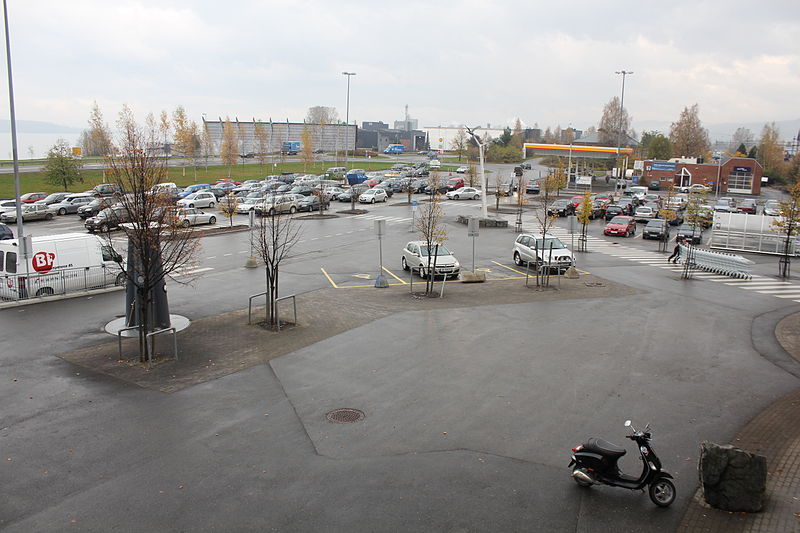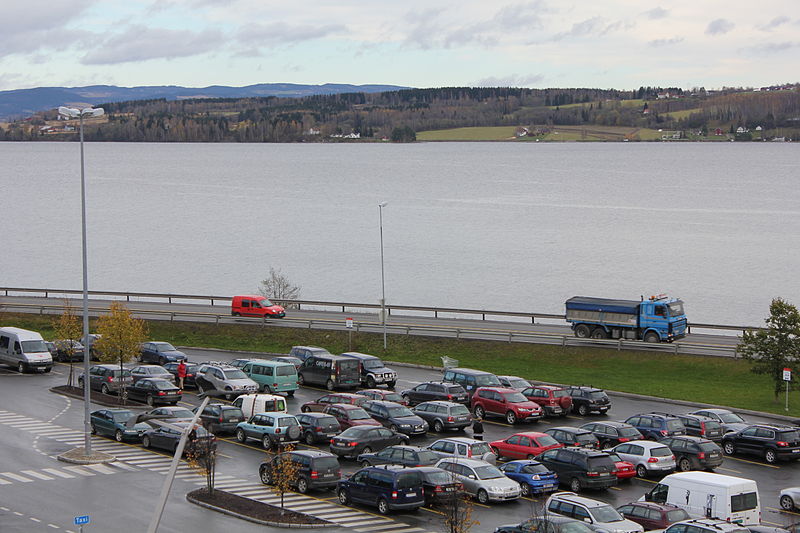The problem is that we are adapting to the wrong things — to images, or to short-term greed, or to the clutter of mechanics. These maladaptations are known as “antipatterns” — a term coined not by Alexander, but by software engineers. An antipattern is something that does things wrong, yet is attractive for some reason (profitable or easy in the short term, but dysfunctional, wasteful of resources, unsustainable, unhealthy in the long term). It also keeps re-appearing. Sounds like our economy and wasteful lifestyle? - Michael Mehaffy and Nikos Salingaros
 |
| CC Gjøvik, an example of a multilayered antipattern |
The permaculture focus is on tracking patterns in nature and design, to create pleasure for ourselves and to find good examples for the world. Patterns work in a multitude of connections with their surroundings, and the more connections there are, the richer are the pattern languages the patterns are part of.
Unfortunately, although our pattern languages might have a deep poetry, not all people feel attracted to their harmony (meaning "the quality without a name"). Today’s disconnected people are attracted by antipatterns, this is because they are profitable or easy in the short term, and human nature is greedy and lazy. We are short term thinkers — in a world of competition the winner takes it all, and today’s capitalism is all about materialism.
Antipatterns are dysfunctional, wasteful of energy and resources, unsustainable and unhealthy in the long term, and they violate the human scale. Still, they are so seductive in their grand scale, and we are overwhelmed by their appearance and shiny surfaces. In fact, we have even made them our new temples!
 |
| Entering the consumerist temple |
Further, antipatterns are disconnected, anti-fractal and non-adapted, the opposite of natural systems. With patterns found in nature and traditional culture we can identify three characteristics:
- Patterns are part of the web of life, with multiple connections sideways, upward and downward, in a kind of network that by Christopher Alexander is described as the pattern language.
- Patterns are part of a fractal structure having a similar degree of organized complexity at all scales, where the large pieces dominate in size and the small ones in numbers. A watershed is a good example of fractal hierarchies found in nature.
- Patterns are adapted and adaptable, where the patterns are reached through a step-by-step process like in morphogenesis. Another name for this process is living technology, while antipatterns are created through the "technologies of death".
This doesn’t mean we should not create a lot of permaculture projects around the world. We should! We need them as positive examples to contrast the antipatterns, so that people can see and understand how insane they are, and can see that alternatives exist. But we cannot expect permaculture technology to conquer the world before antipatterns are fought back!
Another sign of antipatterns is that they look the same around the world, because they are forced structures created out of a blueprint. Patterns on the contrary always attempt a new shape, adapting to local conditions.
The shopping mall of my town consists of several antipatterns, making it a multilayered antipattern. To call it an antipattern language makes no sense, as clusters of antipatterns doesn’t create languages, just noise, keeping no information about life and what it means to be a human being. I have identified four antipatterns of the mall CC Gjøvik, which are all contrasted by an Alexandrine pattern from A Pattern Language.
Antipattern 1, contrasted in the Alexandrine pattern 87, Individually Owned Shops:
Problem
When shops are too large, or controlled by absentee owners, they become plastic, bland, and abstract.
Solution
Do what you can to encourage the development of individually owned shops. Approve applications for business licenses only if the business is owned by those people who actually work and manage the store. Approve new commercial building permits only if the proposed structure includes many very very small rental spaces.
The problem with CC Gjøvik is not just that the shops are too large, but the mall itself is far too large — it might be the largest shopping mall between Oslo and Trondheim. It is situated just outside the core of central town, like a big sponge leaving the town center like lifeless dry land. And not just the town, but villages from all over the region, as everybody wants to go to the largest shopping mall around Lake Mjøsa. It’s like a magnet tapping the surrounding economies for much needed capital.
In America they have come up with a great idea, Small Marts. This is splendid, but for them to thrive antipatterns like CC Gjøvik need to be erased. Unfortunately, for the time it’s growing, just like uncontrolled cancer, recently adding another 7000 square meters.
Pattern 87 is described extensively in my earlier PRI-article: The Ancient Taberna in a Future World.
Problem
When shops are too large, or controlled by absentee owners, they become plastic, bland, and abstract.
Solution
Do what you can to encourage the development of individually owned shops. Approve applications for business licenses only if the business is owned by those people who actually work and manage the store. Approve new commercial building permits only if the proposed structure includes many very very small rental spaces.
The problem with CC Gjøvik is not just that the shops are too large, but the mall itself is far too large — it might be the largest shopping mall between Oslo and Trondheim. It is situated just outside the core of central town, like a big sponge leaving the town center like lifeless dry land. And not just the town, but villages from all over the region, as everybody wants to go to the largest shopping mall around Lake Mjøsa. It’s like a magnet tapping the surrounding economies for much needed capital.
In America they have come up with a great idea, Small Marts. This is splendid, but for them to thrive antipatterns like CC Gjøvik need to be erased. Unfortunately, for the time it’s growing, just like uncontrolled cancer, recently adding another 7000 square meters.
Pattern 87 is described extensively in my earlier PRI-article: The Ancient Taberna in a Future World.
Antipattern 2, contrasted in the Alexandrine pattern 22, Nine Per Cent Parking:
Very simply - when the area devoted to parking is too great, it destroys the land.
Solution
Do not allow more than 9 per cent of the land in any given area to be used for parking. In order to prevent the "bunching" of parking in huge neglected areas, it is necessary for a town or a community to subdivide its land into "parking zones" no larger than 10 acres each and to apply the same rule in each zone.
 |
| My dream is that this can someday be transformed from a car park into the Lake Mjøsa Park, or in Norwegian "Mjøsparken" |
Antipattern 3, contrasted in the Alexandrine pattern 104, Site Repair:
Problem
Buildings must always be built on those parts of the land which are in the worst condition, not the best.
Solution
On no account place buildings in the places which are most beautiful. In fact, do the opposite. Consider the site and its buildings as a single living eco-system. Leave those areas that are the most precious, beautiful, comfortable, and healthy as they are, and build new structures in those parts of the site which are least pleasant now.
 |
| Queen Mjøsa seen from Eiktunet, a small folk museum of Gjøvik. Rather than worshiping her with parks and beauty, my town is constantly mocking her with hostile structures down by her shores. |
Antipattern 4, contrasted in the Alexandrine pattern 25, Access to Water:
People have a fundamental yearning for great bodies of water. But the very movement of the people toward the water can also destroy the water.
Solution
When natural bodies of water occur near human settlements, treat them with great respect. Always preserve a belt of common land, immediately beside the water. And allow dense settlements to come right down to the water only at infrequent intervals along the water's edge.
 |
| At the back side of CC Gjøvik, toward Strandgata (the "beach street" in English, although the beach can no longer be seen). From this parody of an "arcade" you can really feel the "technology of death". |
In spite of the despair I feel when confronted with such a life-destroying, inhuman and unsustainable antipattern like CC Gjøvik, Christopher Alexander gives me hope for a radically new future. A future where antipatterns are not the common, but a future dominated by deeply rooted and strongly interconnected permaculture patterns and languages.
Related reading:
This article is published at The Permaculture Research Institute of Australia on December 6, 2011. Published at Energy Bulletin, USA, on December 21, 2011.






No comments:
Post a Comment
Note: Only a member of this blog may post a comment.